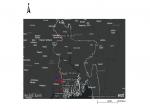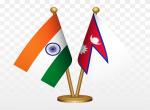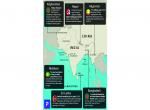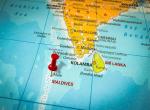The past three months since the Narendra Modi-led NDA government assumed office in India have been momentous in terms of defining, inter alia, a new era of Indo-Nepal relations. The pace at which events have unfolded has been unprecedented. Starting with Nepal Prime Minister Koirala’s visit to New Delhi in end-May 2014 to attend the swearing in ceremony of the Modi cabinet in response to the new govt’s invitation to all the SAARC leaders to the event, there have been two further high level contacts between Kathmandu and New Delhi over a short span of less than two and a half months. On July 25-26, Foreign Minister Sushma Swaraj was in Kathmandu to attend the third meeting of the Nepal India Joint Commission, held after a long gap of 23 years! These were followed by the big one.
Prime Minister Modi paid a two-day high profile visit to on August 3-4, 2014, the first bilateral visit by an Indian Prime Minister to Nepal since 1997 by the then PM, I K Gujral. The long gap between the two visits should certainly not be seen as reflective of any dilution in the importance that India attaches to its relations with a close neighbour like Nepal. Possibly, it was more on account of the internal turmoil and intense political instability that Nepal experienced since the Maoist led armed agitation that commenced in 1996 and eventually led to the establishment of a new political order in 2006. And even after that, political confrontation and the state of uncertainty did not abate. To say the least, it has not been smooth sailing for the newly established dispensation in Nepal that is still struggling to give the country a constitution and a well settled political order even after four years of the first Constituent Assembly and almost a year’s existence of the second.
Modi’s visit was hailed by analysts, media and the political leaders cutting across party lines, as a ‘historic’. This was not so much for the number of agreements and protocols signed or for the commercial deals stuck during the visit. In fact, on these parameters, there could have been a touch of disappointment at the absence of any big-ticket announcements. However, a closer look at the list of issues highlighted in the joint statement issued at the end of the visit does not paint an entirely disappointing picture. Apart from reiteration of the two governments’ determination for promoting sub-regional cooperation through the mechanism of the re-activated Joint Commission, the agreements included a soft credit line of US$ 1 billion, assistance for development work in Janakpur, Baraha Chetra, Lumbini and Pashupatinath, increase in ITEC and Colombo Plan scholarships to 250, setting up of Pancheshwar Development Authority within 6 months for rapid development of the Upper Karnali Hydropower Project, finalization of agreement on Power Trade Agreement (PTA) within 45 days, establishment of Project Development Authorities for Arun III, Upper Marsyangdi and Tamakoshi III, assistance in completion of the Mid Hill Highway, bridge over Mahakali River, completion of Postal and feeder roads, cross border rail connectivity etc.
The visit of PM Modi was, it could be said, more remarkable for its all-round impact on the hearts and minds of the Nepalese people. The Indian Prime Minister managed to convince his political interlocutors and the larger audience comprising the common people that India was not interested in playing the role of ‘a big brother’ but that of an ‘elder brother’. India was Nepal’s ‘best friend’, fully committed to upholding its sovereignty. PM Modi also reiterated India’s willingness to renegotiate the 1950 Treaty of Peace and Friendship, an issue that has been raised oft and on by a motivated section of the Nepalese political parties. Moving a step further, the two Prime Ministers even agreed to review, adjust and upgrade other agreements and treaties as well, to ‘better reflect the current realities’. This should give the govt. and the people of Nepal the level of comfort and assurance that India does not intend to ‘impose’ its will or agenda on them.
It is not yet clear whether the Nepalese side has made up its mind on the shape and content of new or modified agreements that it wants to enter into with India. What is, however, certain that the Nepalese approach to some of their long standing demands on the issue would set the templates for the future shape of bilateral relations. Nepal has to clearly define its priorities. As far as the Modi government is concerned, it has clearly indicated its commitment to work for peace, stability and all round economic development in India’s neighbourhood. It seems prepared to walk the extra mile to achieve this, particularly with Nepal.
His other political messages were equally unambiguous. He stressed the need for Nepal to draft a new constitution providing for a federal democratic republican state that ‘brings the poor and the rich, the rural and the urban, those hailing from the mountains and the Terai’, together. Modi’s message also carried a subtle hint that ethnicity or identity-based polices may not work in the present context. Most significantly, he expressed the view that peace must triumph over war.
While there could be some validity in the general perception about India’s track record in delivering on its project related promises not only in Nepal but even in some of our other neighbours. As far as Nepal is concerned, a part of the blame must be shared by the Nepalese side as well. For one, the leaders there seem to suffer from a pronounced, though highly misplaced, sense of being overwhelmed by India through ‘unequal’ treaties and agreements. They prefer to see a lurking Indian design where none really exists. In contrast, one does not come across any major media campaign of this nature in dealing with bilateral arrangements with other countries! It is entirely up to the leadership to create a favourable environment in Nepal for a more positive and productive engagement, based on trust and understanding. Nepal has to come to a clear determination of what kind of relation it wants to have with India. In this context, political observers maintain that this can happen more easily and smoothly with the establishment of a strong and stable political order in the country.
For far too long, Nepal’s political order has been in a state of flux. In fact, for over the last nearly two decades, the country has been beset by lack of effective governance and absence of development oriented approach to its economic reconstruction. There could be many reasons for this but the prime factors have been identified by political analysts as a bitterly fractured political order resulting in the absence of stable political order, deep rooted suspicion between political parties based on ideological differences, ethnic divides, lack of consensus among the political stakeholders on key issues of national concern, and such others. Most of these problems, it is argued, emanate from two critical decisions taken by the political parties after the ‘revolution’ that established a democratic republican order in the country. These were (i) clubbing together of the tasks of governance and constitution drafting in the same body namely the Constituent Assembly (CA) and (ii) the unwieldy size of the CA itself. As a result of the former, the CA leaders allegedly spent more time and energy in forming alliances to set up governments and then undermining them to form new cabinets. The second decision to establish a large CA with 601 elected representatives only ensured that the body charged with the responsibility of delivering a constitution to the new republic in quick time, could not do so even in four years of extended tenure of the first CA. The leaders could not arrive at workable consensus on critical aspects of the new constitution such as federalism, devolution of power, form of government etc. And the same state of confusion continues even in the new CA.
The preceding two paragraphs may otherwise be perceived as unrelated to the main theme of this paper meant to review the visit of the Indian Prime Minister to Nepal and the prospects for the future course of India-Nepal relations. A closer examination of some of the political issues mentioned above would however reveal their deep connect with the political message that Modi carried for his interlocutors wherein he called upon them to prioritize drafting of the new constitution providing for a federal democratic republican state that would address the aspirations and concerns of all sections of the Nepalese people in an inclusive manner. India as a friendly neighbour should be willing to assist in this task in whatever manner it could, taking great care of Nepalese sensitivities and aspirations and fully respecting its sovereignty.
The challenge to build on these commitments and assurances begins now. Political leadership and the official machineries in both countries will have to get cracking in quick time to follow up on the stated good intents. Initial reports suggest that this has already started happening in Kathmandu and in New Delhi. Latest reports indicate the officials have already beaten the time limit of 45 days by finalizing the PTA within a month! There need not be any doubt that Indian side will pursue the implementation process with the same vigour in a time bound manner. This would also be line PM Modi’s commitment to delivering on his promises. It may be noted that this concern was not only mentioned specifically in the joint statement with the two Prime Ministers expressing concern over the slow pace of implementation of various projects but also by laying down clear time frame for completion of negotiations and agreements. Clearly, the euphoria generated by the visit will be translated into concrete action plans to enable the two countries to build on the existing and to further explore the vast unlimited opportunities that exist for mutually beneficial cooperative relations. It would not be over optimistic a statement to conclude the analysis with the hope that the coming years could well set new markers and bench marks for good neighbourly relations.
Published Date: 8th September 2014, Image source: http://www.thehindu.com









Post new comment